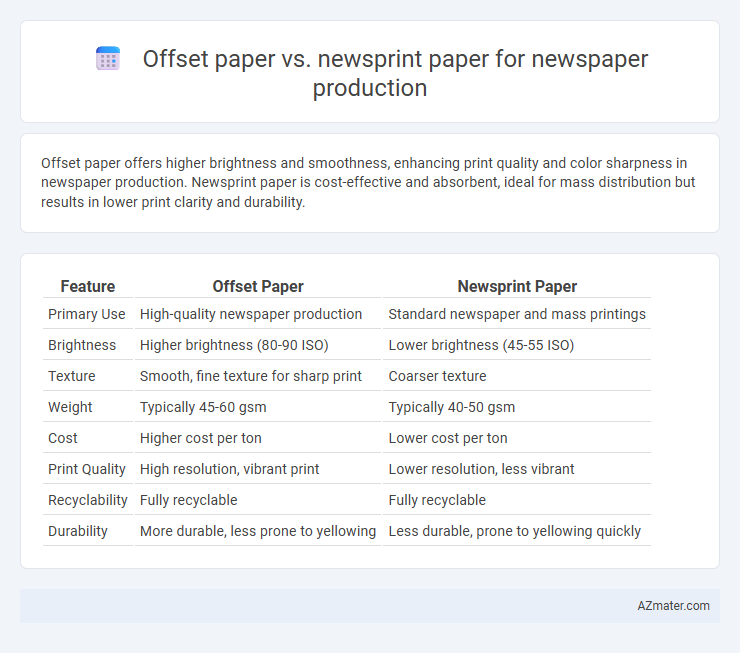Offset paper offers higher brightness and smoothness, enhancing print quality and color sharpness in newspaper production. Newsprint paper is cost-effective and absorbent, ideal for mass distribution but results in lower print clarity and durability.
Table of Comparison
| Feature | Offset Paper | Newsprint Paper |
|---|---|---|
| Primary Use | High-quality newspaper production | Standard newspaper and mass printings |
| Brightness | Higher brightness (80-90 ISO) | Lower brightness (45-55 ISO) |
| Texture | Smooth, fine texture for sharp print | Coarser texture |
| Weight | Typically 45-60 gsm | Typically 40-50 gsm |
| Cost | Higher cost per ton | Lower cost per ton |
| Print Quality | High resolution, vibrant print | Lower resolution, less vibrant |
| Recyclability | Fully recyclable | Fully recyclable |
| Durability | More durable, less prone to yellowing | Less durable, prone to yellowing quickly |
Introduction to Newspaper Paper Types
Offset paper and newsprint paper are the primary materials used in newspaper production, each tailored to specific printing needs. Offset paper features a smooth, coated surface ideal for high-quality offset printing processes, providing sharper images and better ink absorption. Newsprint paper, by contrast, is a lightweight, uncoated material optimized for fast, cost-effective print runs, offering sufficient durability for short-term use and rapid distribution.
Defining Offset Paper and Newsprint Paper
Offset paper, designed for high-quality printing processes, features a smooth surface and superior opacity, making it ideal for offset printing presses in newspaper production. Newsprint paper, primarily composed of mechanical wood pulp, offers lower brightness and bulk but provides cost-effective, lightweight material specifically optimized for high-speed rotary presses. Choosing between offset paper and newsprint hinges on balancing print quality, production speed, and budget constraints in newspaper manufacturing.
Composition and Manufacturing Differences
Offset paper for newspaper production is primarily composed of wood pulp with additives like fillers and sizing agents to enhance print quality, resulting in a smooth, bright surface ideal for high-resolution images. Newsprint paper, by contrast, is made from mechanical pulp with less processing and fewer additives, yielding a coarser texture and lower brightness suited for short-term use and cost efficiency. Manufacturing offset paper involves chemical pulping and extensive refining to improve strength and uniformity, while newsprint relies on mechanical pulping methods that retain more lignin, impacting durability and recyclability.
Print Quality: Offset vs Newsprint
Offset paper offers superior print quality for newspaper production due to its smooth, coated surface that delivers sharper images and more vibrant color reproduction compared to newsprint paper. Newsprint paper, being uncoated and more porous, tends to absorb more ink, resulting in lower resolution and less color vibrancy. The choice of offset paper enhances the overall visual appeal of newspapers, making text and images crisper and more engaging to readers.
Durability and Longevity Comparison
Offset paper offers superior durability and longevity compared to newsprint paper, making it a preferred choice for high-quality newspaper production. Its higher pulp quality and smoother surface resist yellowing and brittleness over time, ensuring the printed content remains clear and intact longer. Newsprint paper, being more cost-effective, tends to degrade faster due to lower fiber quality and higher acidity, leading to quicker fading and physical deterioration.
Cost Implications for Newspaper Production
Offset paper typically incurs higher costs than newsprint due to its superior quality and durability, making it suitable for newspapers prioritizing print clarity and longevity. Newsprint paper offers a cost-effective option, widely favored for high-volume newspaper production because of its lower price and faster production availability. Choosing between offset paper and newsprint significantly impacts the overall budget, balancing print quality demands against tight financial constraints in large-scale newspaper publishing.
Environmental Impact and Sustainability
Offset paper, commonly used for high-quality newspaper production, is typically sourced from sustainably managed forests and often contains recycled fibers, reducing deforestation and promoting environmental sustainability. Newsprint paper, while cheaper and widely used, relies heavily on virgin pulp, leading to higher energy consumption and greater environmental degradation during production. Choosing recycled content offset paper improves the carbon footprint and supports circular economy practices in newspaper printing.
Suitability for Digital Printing Techniques
Offset paper is highly suitable for digital printing techniques due to its smooth surface and consistent weight, allowing precise ink absorption and vibrant color reproduction. Newsprint paper, being more porous and lightweight, often results in lower print quality with less sharpness and color vibrancy, making it less ideal for advanced digital presses. Digital presses benefit from offset paper's durability and higher opacity, which reduce ink bleed-through and enhance overall print clarity in newspaper production.
Reader Experience and Visual Appeal
Offset paper offers a smoother surface and higher brightness compared to newsprint paper, enhancing the sharpness and color vibrancy of newspaper images and text. Newsprint paper, being more porous and lower in brightness, can result in less crisp visuals and muted colors, potentially affecting readability and visual appeal. Readers often perceive offset paper newspapers as more premium and engaging due to better print quality and durability.
Choosing the Right Paper for Your Newspaper
Offset paper offers superior print quality and durability compared to newsprint, making it ideal for newspapers that require sharp images and vibrant colors. Newsprint is more cost-effective and lightweight, suitable for high-volume, short-lifespan publications where budget and rapid production are priorities. Selecting the right paper depends on the balance between print quality, budget constraints, and the newspaper's distribution lifespan.

Infographic: Offset paper vs Newsprint paper for Newspaper production
 azmater.com
azmater.com